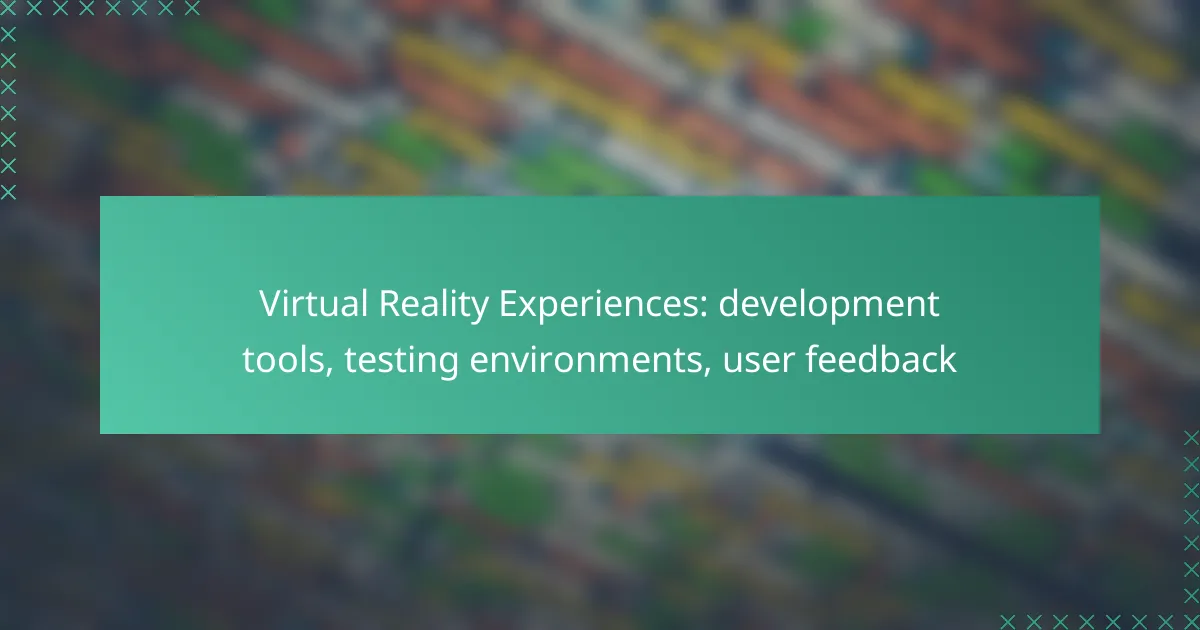Virtual reality experiences rely on a variety of development tools, such as Unity and Unreal Engine, to create immersive environments. Establishing a proper testing environment is essential for evaluating these experiences, requiring the right hardware and software configurations. Additionally, gathering user feedback through surveys and testing sessions plays a critical role in refining VR applications and enhancing user satisfaction.
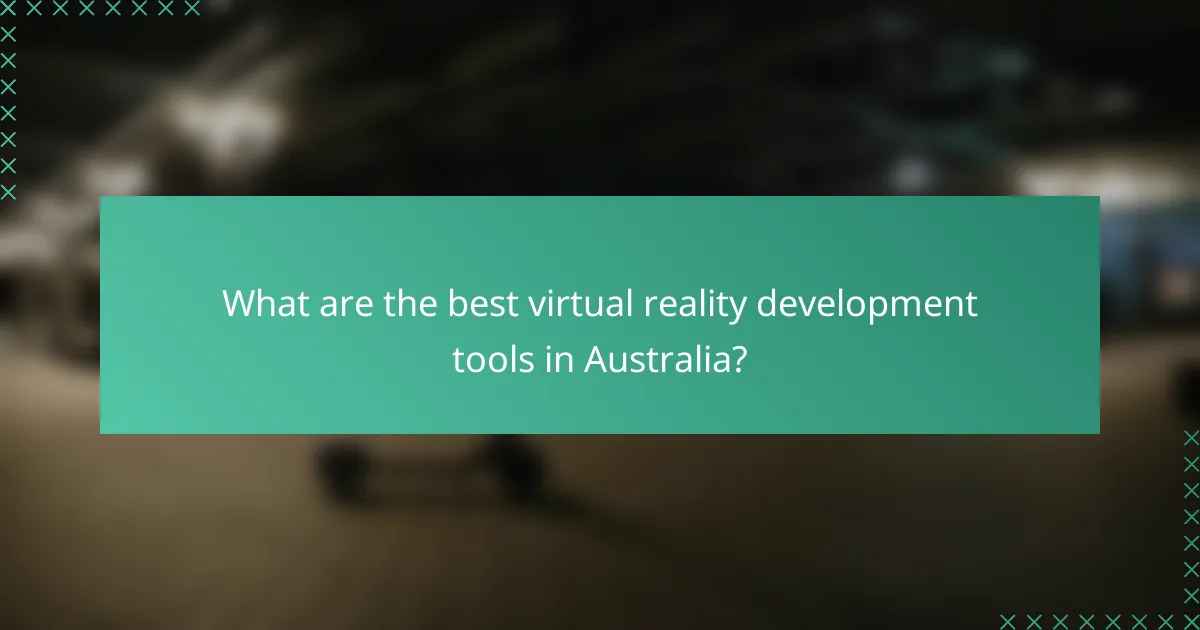
What are the best virtual reality development tools in Australia?
The best virtual reality development tools in Australia include Unity, Unreal Engine, Amazon Sumerian, Blender, and WebXR. Each tool offers unique features and capabilities that cater to different aspects of VR development, from game design to immersive experiences.
Unity
Unity is one of the most popular development platforms for creating virtual reality experiences. It supports a wide range of VR hardware and provides a user-friendly interface, making it accessible for both beginners and experienced developers. Unity’s asset store offers a plethora of resources, including 3D models and scripts, which can accelerate the development process.
When using Unity, consider leveraging its built-in VR templates and tools for optimizing performance. Common pitfalls include neglecting to test on actual hardware, which can lead to performance issues or user experience flaws.
Unreal Engine
Unreal Engine is known for its high-quality graphics and robust capabilities, making it ideal for creating visually stunning VR experiences. It uses a node-based scripting system called Blueprints, which allows developers to create complex interactions without extensive coding knowledge.
For developers in Australia, Unreal Engine’s support for VR development is comprehensive, but it may require a steeper learning curve compared to Unity. Focus on optimizing assets and using the engine’s profiling tools to ensure smooth performance across various VR devices.
Amazon Sumerian
Amazon Sumerian is a cloud-based platform that simplifies the creation of VR and AR applications. It allows developers to build immersive experiences without needing extensive programming skills. Sumerian integrates well with other AWS services, providing powerful backend support for applications.
While Sumerian is user-friendly, it may not offer the same level of customization as Unity or Unreal Engine. It’s best suited for projects that require quick deployment and integration with cloud services, especially for businesses looking to create training simulations or marketing experiences.
Blender
Blender is a free, open-source 3D modeling tool that is widely used in the VR development community. It allows developers to create detailed 3D assets that can be imported into other VR platforms like Unity and Unreal Engine. Blender’s extensive features include sculpting, texturing, and animation tools.
While Blender is powerful, it can be complex for newcomers. Developers should invest time in learning the interface and best practices for exporting assets to ensure compatibility with their chosen VR development tool.
WebXR
WebXR is an API that enables the creation of virtual and augmented reality experiences directly in web browsers. This technology allows developers to reach a broader audience without requiring users to download separate applications. WebXR supports various devices, making it a flexible option for VR development.
When using WebXR, focus on optimizing performance for web environments, as browser capabilities can vary. Developers should also consider accessibility and user experience, ensuring that VR content is easy to navigate and interact with on different devices.
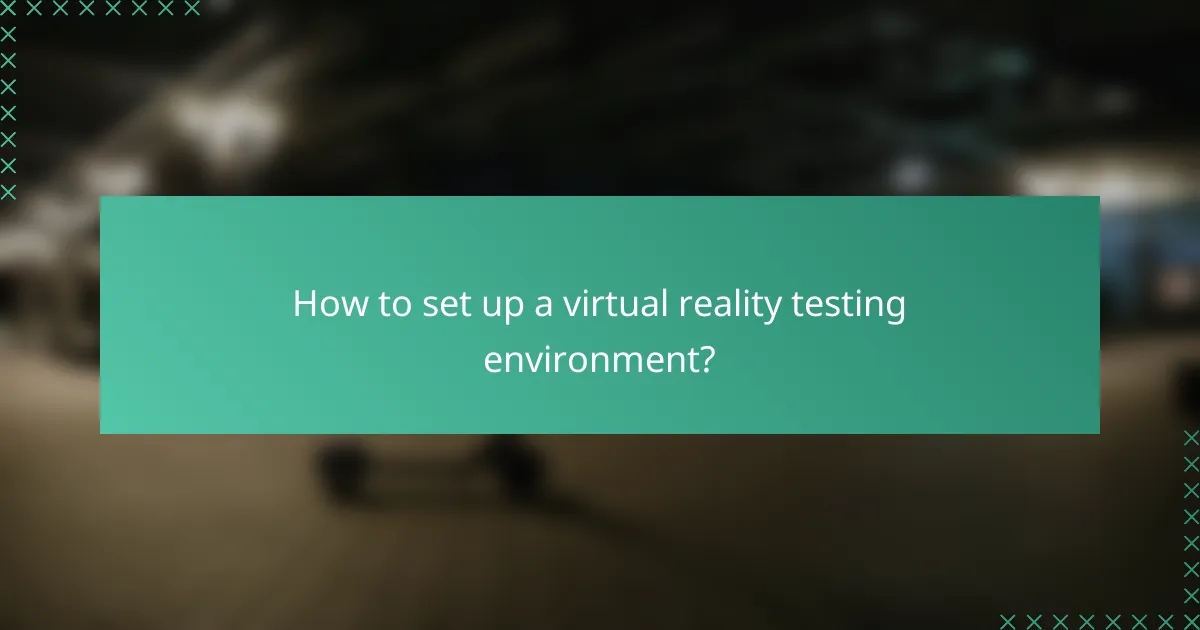
How to set up a virtual reality testing environment?
Setting up a virtual reality testing environment involves ensuring you have the right hardware, software, and network configurations. This setup is crucial for accurately evaluating VR experiences and gathering user feedback effectively.
Hardware requirements
To create a virtual reality testing environment, you need specific hardware components. A powerful computer with a high-end GPU is essential, typically from brands like NVIDIA or AMD, to handle the demanding graphics of VR applications.
Additionally, VR headsets such as the Oculus Rift, HTC Vive, or Valve Index are necessary for immersive testing. Ensure that you have adequate sensors and controllers, as these enhance user interaction and experience.
Software configuration
Software setup includes installing the necessary VR development tools and platforms, such as Unity or Unreal Engine, which support VR content creation. Make sure to configure the software to recognize your VR hardware and optimize settings for performance.
Testing environments often require specific SDKs (Software Development Kits) for the VR hardware being used. For example, Oculus SDK or SteamVR SDK should be installed and properly configured to facilitate seamless interaction between the software and hardware.
Network setup
A reliable network connection is critical for multiplayer VR experiences or cloud-based testing. Ensure that your testing environment has a stable internet connection, ideally with low latency and high bandwidth, to support real-time interactions.
Consider using a wired connection for the testing PC to minimize latency issues. If using wireless VR, ensure the Wi-Fi network is robust enough to handle the data transfer without interruptions, ideally operating on a 5 GHz band.
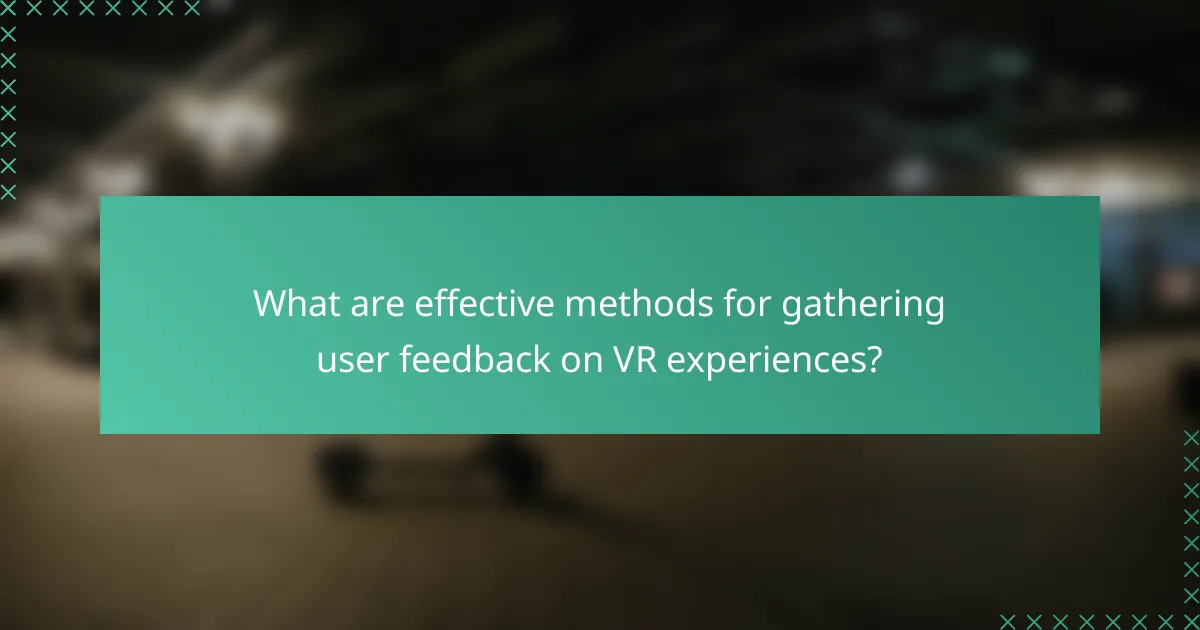
What are effective methods for gathering user feedback on VR experiences?
Effective methods for gathering user feedback on VR experiences include surveys, user testing sessions, and analytics tools. Each method provides unique insights that can help developers enhance the overall user experience and address specific issues.
Surveys and questionnaires
Surveys and questionnaires are straightforward tools for collecting user feedback on VR experiences. They can be distributed digitally or integrated within the VR application, allowing users to provide their thoughts immediately after use.
When designing surveys, focus on both quantitative and qualitative questions. Use a mix of rating scales for specific features and open-ended questions for detailed feedback. Aim for a completion time of under 5 minutes to encourage higher response rates.
User testing sessions
User testing sessions involve observing real users as they interact with the VR experience. This method provides direct insights into user behavior, preferences, and pain points that might not be captured through surveys.
To conduct effective user testing, select a diverse group of participants that represent your target audience. Sessions should last around 30 to 60 minutes, allowing enough time for users to explore the experience while providing feedback. Record sessions for later analysis, but ensure participants are comfortable with this.
Analytics tools
Analytics tools track user interactions within the VR experience, providing data on usage patterns, engagement levels, and drop-off points. This quantitative data complements qualitative feedback from surveys and testing sessions.
Implement analytics solutions that can capture metrics such as session duration, frequency of use, and specific actions taken within the VR environment. Tools like Google Analytics or specialized VR analytics platforms can help you gather and interpret this data effectively. Regularly review the analytics to identify trends and areas for improvement.
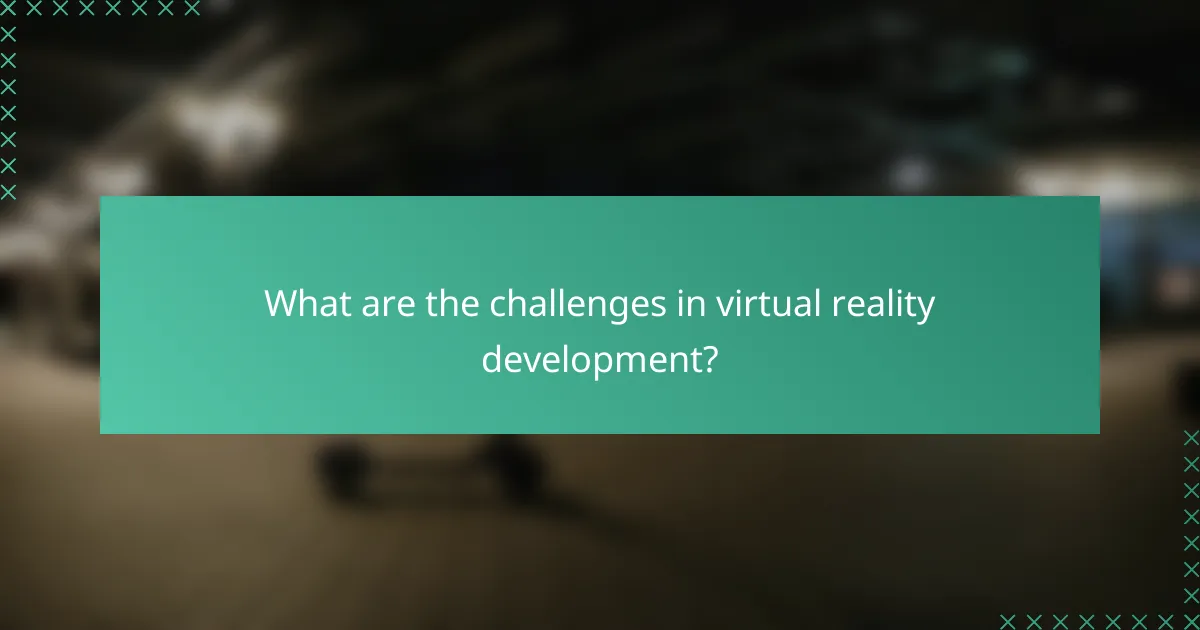
What are the challenges in virtual reality development?
Virtual reality development faces several significant challenges, including technical limitations, user experience issues, and cost considerations. Addressing these challenges is crucial for creating immersive and effective VR experiences.
Technical limitations
Technical limitations in virtual reality often stem from hardware constraints, such as processing power and graphics capabilities. Many VR systems require high refresh rates and low latency to provide a smooth experience, which can be difficult to achieve with current technology.
Additionally, compatibility issues between different devices and platforms can hinder development. Developers must ensure their applications work seamlessly across various VR headsets, which may have different specifications and capabilities.
User experience issues
User experience issues in virtual reality can significantly impact engagement and satisfaction. Common problems include motion sickness, which can occur due to mismatches between visual input and physical movement. Developers need to implement design strategies that minimize these effects, such as maintaining a stable frame rate and using appropriate field of view.
Another challenge is creating intuitive user interfaces that are easy to navigate in a 3D space. Developers should prioritize usability by conducting user testing and iterating on feedback to refine interactions and controls.
Cost considerations
Cost considerations are a major factor in virtual reality development, as creating high-quality VR experiences can be expensive. Expenses include hardware, software licenses, and skilled labor, which can quickly add up. Developers should budget carefully and explore cost-effective tools and platforms that can streamline the development process.
Moreover, ongoing maintenance and updates can incur additional costs. It’s essential to plan for the long-term support of VR applications, including regular updates to keep up with technological advancements and user expectations.

How to choose the right VR development tool?
Selecting the right VR development tool hinges on understanding your project’s specific needs, the expertise of your team, and your budget. A well-suited tool can streamline the development process and enhance the final user experience.
Project requirements
Begin by clearly defining your project requirements, including the type of VR experience you aim to create—be it gaming, training, or simulation. Different tools cater to various functionalities, such as 3D modeling, animation, or real-time rendering.
Consider the target platform as well; some tools are optimized for specific hardware like Oculus Rift or HTC Vive, while others are more versatile. Assessing the complexity of your project will help narrow down your options.
Team expertise
Your team’s familiarity with programming languages and development environments significantly influences the choice of tools. For instance, if your team is proficient in C#, Unity might be a favorable option due to its user-friendly interface and extensive resources.
Evaluate whether your team has experience with VR-specific design principles, as this can affect the quality of the user experience. If your team lacks VR experience, consider tools with robust community support and tutorials to facilitate learning.
Budget constraints
Budget is a critical factor when selecting VR development tools, as costs can vary widely. Free or open-source tools like Blender can be a good starting point for smaller projects, while premium tools may offer advanced features at a higher price point.
Factor in not just the initial costs but also ongoing expenses such as licensing fees, hardware requirements, and potential training costs. Establishing a clear budget will help you make informed decisions without overspending.
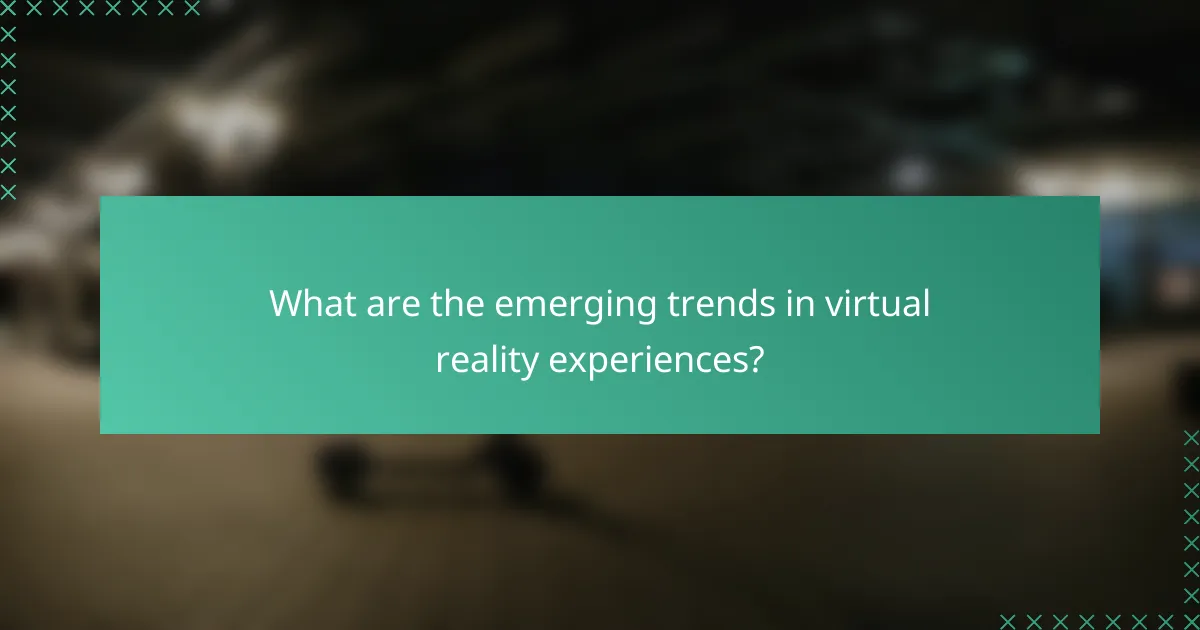
What are the emerging trends in virtual reality experiences?
Emerging trends in virtual reality (VR) experiences focus on enhancing user interactivity, social engagement, and immersive storytelling. Innovations in hardware and software are driving these trends, making VR more accessible and appealing to a wider audience.
Social VR platforms
Social VR platforms allow users to interact in virtual environments, creating shared experiences that mimic real-life social interactions. These platforms often feature customizable avatars, virtual spaces for gatherings, and tools for communication, such as voice chat and gestures.
Popular examples include platforms like VRChat and Rec Room, which enable users to create and join various activities, from games to social meetups. When developing for social VR, consider the balance between user-generated content and moderation to maintain a safe environment.
To maximize user engagement, focus on intuitive design and seamless integration of social features. Avoid overwhelming users with complex controls; instead, prioritize ease of use and accessibility to encourage participation from diverse demographics. Regularly gather user feedback to refine the experience and address any issues promptly.
